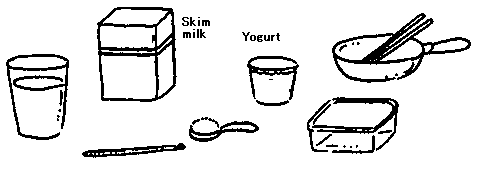Internet Version [Naruhodo no Mori] Vol.56
by Yumiko Mori

Vol.56 March 15th, 2001
Increasing Yogurt Bacteria
Research on Bacteria
Home science experiments for mothers of elementary school children


Mom and Satoshi watch what happens. They notice the milk is becoming more viscous.
Mom: "Satoshi, look!
Yogurt is ready."
Satoshi: "Is this ready?"
Mom: "Yes. But why are you asking?"
Satoshi: "Mom, you said 'yogurt will grow'.
I thought it is going to fill this cup.
This is not growing at all."
| Milk | 500 ml |
| Skim milk | 1/4 cup |
| Sugar | 50g |
| Yogurt | 50g |
| A container with its lid (heat resistant one) | |
| A Pot | |
| A pair of chop sticks | |
| If available, a thermometer | |



* If you add more skim milk, you can get harder yogurt.
* Eat yogurt with fruits or nata de coco, it is delicious!
How much did the number of the bacteria increase in the yogurt? A common human bacteria, Escherichia coli, divides once every 20 minutes in favorable conditions. That means the number of the bacteria grows 2 times in 20 minutes, 4 times in 40 minutes, 8 times in 1 hour, and 4096 times in 4 hours. 1 gram of yogurt contains several billion bacteria cells. So, the number of bacteria will become huge. Microorganisms such as bacteria, fungus, and mold are used in various fields such as food industry, medicine, agriculture, energy industry, and environment improvement. I think microbiological research has bright future along with other biotechnologies.
| Author | Yumiko Mori (Zushi, Kanagawa, Japan) |
|---|---|
| Illustration | Mitsue Ogata |
| Translator | Akira Ishihara |
| HTML format | Muneo Kume |

